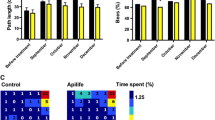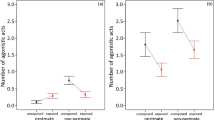Abstract
To locate their western honey bee (Apis mellifera) hosts, parasitic Varroa destructor mites depend on tactile and especially chemosensory cues. Modifying these cues in the honey bee colony environment may show potential for use as a means of managing Varroa destructor mite populations. We tested whether chemical compound, previously detected in honey bee colonies or extracted from honey bees and V. destructor mites, modified V. destructor locomotion behaviour. In experiments quantifying time spent by V. destructor mites within areas treated with different chemical compounds, we observed non-significant increasing tendencies in concentration-dependent locomotion behavioural responses. Varroa destructor responses towards compounds tested with different emission sources (e.g. stearic acid, sebacic acid, and racemic ocimene) suggest that mites may use multiple cues to orient within a colony environment. Determination of V. destructor locomotion behavioural sensitivity to individual compounds and blends provides baseline information for future exploration into managing mite infestations using low-volatility compounds at concentrations relevant to V. destructor.


Similar content being viewed by others
Data availability
The datasets generated and analysed during the current study are available from the corresponding author on request.
References
Bates D, Maechler M, Bolker B, Walker S (2015) Linear mixed-effects models using lme4. J Stat Softw 67:1–48. https://doi.org/10.18637/jss.v067.i01
Boot WJ (1994) Methyl palmitate does not elicit invasion of honeybee brood cells by Varroa mites. Exp Appl Acarol 18:587–592. https://doi.org/10.1007/BF00051721
Bubnič J, Moosbeckhofer R, Prešern J et al (2021) Three pillars of Varroa control. Apidologie 52:1305–1333. https://doi.org/10.1007/s13592-021-00903-4
Calderone NW, Lin S (2001) Behavioural responses of Varroa destructor (Acari: Varroidae) to extracts of larvae, cocoons and brood food of worker and drone honey bees, Apis mellifera (Hymenoptera: Apidae). Physiol Entomol 26:341–350. https://doi.org/10.1046/j.0307-6962.2001.00254.x
Carroll MJ, Duehl AJ (2012) Collection of volatiles from honeybee larvae and adults enclosed on brood frames. Apidologie 43:715–730. https://doi.org/10.1007/s13592-012-0153-x
Currie RW, Pernal SF, Guzmán-Novoa E (2010) Honey bee colony losses in Canada. J Apic Res 49:104–106. https://doi.org/10.3896/IBRA.1.49.1.18
De Jong D, Morse RA, Eickwort GC (1982) Mite pests of honey bees. Annu Rev Entomol 27:229–252. https://doi.org/10.1146/annurev.en.27.010182.001305
Dietemann V, Nazzi F, Martin SJ et al (2013) Standard methods for Varroa research. J Apic Res 52:1–54. https://doi.org/10.3896/IBRA.1.52.1.09
Dietemann V, Pflugfelder J, Anderson D et al (2012) Varroa destructor: research avenues towards sustainable control. J Apic Res 51:125–132. https://doi.org/10.3896/IBRA.1.51.1.15
Donzé G, Schnyder-Candrian S, Bogdanov S et al (1998) Aliphatic alcohols and aldehydes of the honey bee cocoon induce arrestment behavior in Varroa jacobsoni (Acari: Mesostigmata), an ectoparasite of Apis mellifera. Arch Insect Biochem 37:129–145. https://doi.org/10.1002/(SICI)1520-6327(1998)37:2%3c129::AID-ARCH2%3e3.0.CO;2-P
Drijfhout FP, Kochansky J, Lin S, Calderone NW (2005) Components of honeybee royal jelly as deterrents of the parasitic Varroa mite, Varroa destructor. J Chem Ecol 31:1747–1764. https://doi.org/10.1007/s10886-005-5925-6
Ferland J, Claing G, Kempers M, et al (2021) Canadian association of professional apiculturists (CAPA): Statement on honey bee wintering losses in canada. Quebec. 1–24. https://capabees.com/shared/CAPA-Statement-on-Colony-Losses-2020-2021.pdf
Ferland J, Nasr M, Wilson G, et al (2017) Canadian association of professional apiculturists (CAPA): statement on honey bee wintering losses in Canada. Quebec. 1–15. https://capabees.com/shared/2016/07/2017-CAPA-Statement-on-Colony-Losses-r.pdf
Frey E, Odemer R, Blum T, Rosenkranz P (2013) Activation and interruption of the reproduction of Varroa destructor is triggered by host signals (Apis mellifera). J Invertebr Pathol 113:56–62. https://doi.org/10.1016/j.jip.2013.01.007
Fries I, Imdorf A, Rosenkranz P (2006) Survival of mite infested (Varroa destructor) honey bee (Apis mellifera) colonies in a nordic climate. Apidologie 37:564–570. https://doi.org/10.1051/apido:2006031
Gilley DC, DeGrandi-Hoffman G, Hooper JE (2006) Volatile compounds emitted by live European honey bee (Apis mellifera L.) queens. J Insect Physiol 52:520–527. https://doi.org/10.1016/j.jinsphys.2006.01.014
Grenacher S, Kröber T, Guerin PM, Vlimant M (2001) Behavioural and chemoreceptor cell responses of the tick, Ixodes ricinus, to its own faeces and faecal constituents. Exp Appl Acarol 25:641–660. https://doi.org/10.1023/A:1016145805759
Gries R, Britton R, Holmes M et al (2015) Bed bug aggregation pheromone finally identified. Angew Chem Int Ed 54:1135–1138. https://doi.org/10.1002/anie.201409890
Grozinger CM, Fischer P, Hampton JE (2007) Uncoupling primer and releaser responses to pheromone in honey bees. Naturwissenschaften 94:375–379. https://doi.org/10.1007/s00114-006-0197-8
Hartig F (2021) DHARMa: residual diagnostics for hierarchical (multi-level/mixed) regression models. http://florianhartig.github.io/DHARMa/
Joerges J, Küttner A, Galizia CG, Menzel R (1997) Representations of odours and odour mixtures visualized in the honeybee brain. Nature 387:285–288. https://doi.org/10.1038/387285a0
Le Conte Y, Arnold G, Trouiller J et al (1990) Identification of a brood pheromone in honeybees. Naturwissenschaften 77:334–336. https://doi.org/10.1007/BF01138390
Le Conte Y, Arnold G, Trouiller J et al (1989) Attraction of the parasitic mite Varroa to the drone larvae of honey bees by simple aliphatic esters. Science 245:638–639. https://doi.org/10.1126/science.245.4918.638
Lee S, Lee DK (2018) What is the proper way to apply the multiple comparison test? Korean J Anesthesiol 71:353–360. https://doi.org/10.4097/kja.d.18.00242
Lenth R (2020) emmeans: estimated marginal means, aka least-squares means. https://cran.r-project.org/package=emmeans
Lercker G, Capella P, Conte LS et al (1981) Components of royal jelly: identification of the organic acids. Lipids 16:912–919. https://doi.org/10.1007/BF02534997
Light M, Shutler D, Cutler GC, Hillier NK (2020a) Varroa destructor mite electrophysiological responses to honey bee (Apis mellifera) colony volatiles. Exp Appl Acarol 81:495–514. https://doi.org/10.1007/s10493-020-00519-w
Light M, Shutler D, Cutler GC, Hillier NK (2020b) Electrotarsogram responses to synthetic odorants by Varroa destructor, a primary parasite of western honey bees (Apis mellifera). Exp Appl Acarol 81:515–530. https://doi.org/10.1007/s10493-020-00525-y
Ma R, Villar G, Grozinger CM, Rangel J (2018) Larval pheromones act as colony-wide regulators of collective foraging behavior in honeybees. Behav Ecol 29:1132–1141. https://doi.org/10.1093/beheco/ary090The
Martin C, Provost E, Bagnères AG et al (2002) Potential mechanism for detection by Apis mellifera of the parasitic mite Varroa destructor inside sealed brood cells. Physiol Entomol 27:175–188. https://doi.org/10.1046/j.1365-3032.2002.00284.x
McAfee A, Collins TF, Madilao LL, Foster LJ (2017) Odorant cues linked to social immunity induce lateralized antenna stimulation in honey bees (Apis mellifera L.). Sci Rep 7:46171. https://doi.org/10.1038/srep46171
Milani N (1999) The resistance of Varroa jacobsoni Oud. to acaricides. Apidologie 30:229–234. https://doi.org/10.1051/apido:19990211
Nazzi F, Milani N, Della Vedova G (2004) A semiochemical from larval food influences the entrance of Varroa destructor into brood cells. Apidologie 35:403–410. https://doi.org/10.1051/apido:2004023
Pankiw T, Page RE (2001) Brood pheromone modulates honeybee (Apis mellifera L.) sucrose response thresholds. Behav Ecol Sociobiol 49:206–213. https://doi.org/10.1007/s002650000282
Pernal SF, Baird DS, Birmingham AL et al (2005) Semiochemicals influencing the host-finding behaviour of Varroa destructor. Exp Appl Acarol 37:1–26. https://doi.org/10.1007/s10493-005-1117-x
Plettner E, Eliash N, Singh NK et al (2017) The chemical ecology of host-parasite interaction as a target of Varroa destructor control agents. Apidologie 48:78–92. https://doi.org/10.1007/s13592-016-0452-8
Reinhard J, Sinclair M, Srinivasan MV, Claudianos C (2010) Honeybees learn odour mixtures via a selection of key odorants. PLoS ONE 5:1–14. https://doi.org/10.1371/journal.pone.0009110
Rickli M, Diehl PA, Guerin PM (1994) Cuticle alkanes of honeybee larvae mediate arrestment of bee parasite Varroa jacobsoni. J Chem Ecol 20:2437–2453. https://doi.org/10.1007/BF02033212
Rickli M, Guerin PM, Diehl PA (1992) Palmitic acid released from honeybee worker larvae attracts the parasitic mite Varroa jacobsoni on a servosphere. Naturwissenschaften 79:320–322. https://doi.org/10.1007/BF01138711
Ritter W (2008) Varroosis of honey bees (infestation of honey bees with Varroa spp.). In: Manual of diagnostic tests and vaccines for terrestrial animals 2018, May. OIE World Organization for Animal Health, pp 1–13. https://www.woah.org/fileadmin/Home/eng/Health_standards/tahm/3.02.07_VARROOSIS.pdf
Schmid-Hempel P (1995) Parasites in social insects. Apidologie 25:255–271. https://doi.org/10.1051/apido:19950307
Seeley TD, Smith ML (2015) Crowding honeybee colonies in apiaries can increase their vulnerability to the deadly ectoparasite Varroa destructor. Apidologie 46:716–727. https://doi.org/10.1007/s13592-015-0361-2
Trouiller J, Arnold G, Chappe B et al (1994) The kairomonal esters attractive to the Varroa jacobsoni mite in the queen brood. Apidologie 25:314–321. https://doi.org/10.1051/apido:19940306
Trouiller J, Arnold G, Chappe B et al (1992) Semiochemical basis of infestation of honey bee brood by Varroa jacobsoni. J Chem Ecol 18:2041–2053. https://doi.org/10.1007/BF00981926
van der Zee R, Pisa L, Andonov S et al (2012) Managed honey bee colony losses in Canada, China, Europe, Israel and Turkey, for the winters of 2008–9 and 2009–10. J Apic Res 51:100–114. https://doi.org/10.3896/IBRA.1.51.1.12
Yoder JA, Sammataro D (2003) Potential to control Varroa mites (Acari: Varroidae) using chemical ecology. Int J Acarol 29:139–143. https://doi.org/10.1080/01647950308683652
Ziegelmann B, Lindenmayer A, Steidle J, Rosenkranz P (2013a) The mating behavior of Varroa destructor is triggered by a female sex pheromone. Part 1: preference behavior of male mites in a laboratory bioassay. Apidologie 44:314–323. https://doi.org/10.1007/s13592-012-0182-5
Ziegelmann B, Rosenkranz P (2014) Mating disruption of the honeybee mite Varroa destructor under laboratory and field conditions. Chemoecology 24:137–144. https://doi.org/10.1007/s00049-014-0155-4
Ziegelmann B, Tolasch T, Steidle JLM, Rosenkranz P (2013b) The mating behavior of Varroa destructor is triggered by a female sex pheromone. Part 2: identification and dose-dependent effects of components of the Varroa sex pheromone. Apidologie 44:481–490. https://doi.org/10.1007/s13592-013-0198-5
Funding
Atlantic Canada Opportunities Agency Atlantic Innovation Fund (#197853), Canada Foundation for Innovation (22087), Natural Sciences and Engineering Research Council of Canada (RGPIN-2017–04319), and Project Apis m.
Author information
Authors and Affiliations
Contributions
All authors contributed to the study conception and design. Material preparation and data collection were performed by Michael Light. Analysis was performed by Michael Light, N. Kirk Hillier, Nicoletta Faraone, and Dave Shutler. The first draft of the manuscript was written by Michael Light, and all authors commented on the previous versions of the manuscript. All authors read and approved the final manuscript.
Corresponding author
Ethics declarations
Conflict of interest
The authors have no relevant financial or non-financial interests to disclose.
Additional information
Communicated by Antonio Biondi.
Publisher's Note
Springer Nature remains neutral with regard to jurisdictional claims in published maps and institutional affiliations.
Electronic supplementary material
Below is the link to the electronic supplementary material.
Rights and permissions
Springer Nature or its licensor (e.g. a society or other partner) holds exclusive rights to this article under a publishing agreement with the author(s) or other rightsholder(s); author self-archiving of the accepted manuscript version of this article is solely governed by the terms of such publishing agreement and applicable law.
About this article
Cite this article
Light, M., Shutler, D., Faraone, N. et al. Locomotion behavioural responses of Varroa destructor exposed to western honey bee (Apis mellifera) semiochemicals. J Pest Sci 97, 757–766 (2024). https://doi.org/10.1007/s10340-023-01668-8
Received:
Revised:
Accepted:
Published:
Issue Date:
DOI: https://doi.org/10.1007/s10340-023-01668-8




